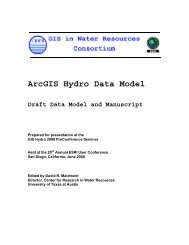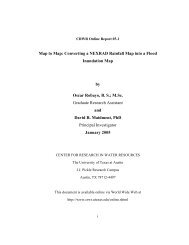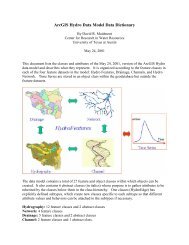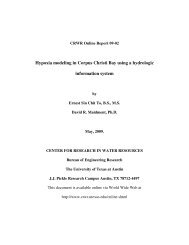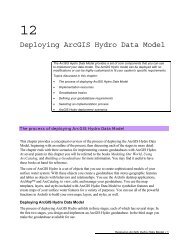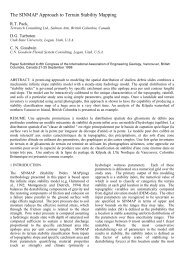View the Whole Report - Center for Research in Water Resources ...
View the Whole Report - Center for Research in Water Resources ...
View the Whole Report - Center for Research in Water Resources ...
Create successful ePaper yourself
Turn your PDF publications into a flip-book with our unique Google optimized e-Paper software.
observation demonstrates that field per<strong>for</strong>mance can not be determ<strong>in</strong>ed from current<br />
parameters used to characterize <strong>the</strong> hydraulic properties of <strong>the</strong>se fabrics.<br />
The mean removal efficiency of <strong>the</strong> rock berm, when <strong>the</strong> removal efficiency of <strong>the</strong><br />
flume itself is subtracted, was approximately 7%. This removal efficiency is similar to<br />
reports of sediment trapp<strong>in</strong>g efficiency <strong>for</strong> rock berms <strong>in</strong> <strong>the</strong> field (Reed, 1980; Weber<br />
and Wilson, 1976). The <strong>in</strong>fluent flow rate <strong>for</strong> <strong>the</strong> rock berm was <strong>the</strong> highest used <strong>in</strong> <strong>the</strong><br />
tests and should have caused <strong>the</strong> TSS removal efficiency of <strong>the</strong> flume itself to be a<br />
m<strong>in</strong>imum; <strong>the</strong>re<strong>for</strong>e, <strong>the</strong> 7 % efficiency is a m<strong>in</strong>imum value.<br />
5.1.9 Effects of Sediment Clogg<strong>in</strong>g and Ra<strong>in</strong>fall Wash<strong>in</strong>g<br />
The detention times <strong>for</strong> each test with respect to <strong>the</strong> time of test<strong>in</strong>g are presented<br />
<strong>in</strong> Figure 5.7. The ra<strong>in</strong>fall data from a nearby monitor<strong>in</strong>g station also are plotted. When<br />
<strong>the</strong> series of tests of an <strong>in</strong>dividual silt fence are compared, subsequent tests show an<br />
<strong>in</strong>crease <strong>in</strong> <strong>the</strong> detention time. This phenomenon is likely caused by sediment<br />
100000<br />
80<br />
70<br />
Detention Time, m<strong>in</strong><br />
10000<br />
1000<br />
100<br />
60<br />
50<br />
40<br />
30<br />
20<br />
Ra<strong>in</strong>fall, mm<br />
Ra<strong>in</strong>fall<br />
Belton woven<br />
Exxon woven<br />
Mirafi A non-woven<br />
Mirafi B non-woven<br />
Amoco woven<br />
10<br />
10<br />
0<br />
4/4/94 5/2/94 5/29/94 6/26/94 7/24/94 8/21/94 9/18/94<br />
Date<br />
Figure 5.7 Detention Times as a Function of Test<strong>in</strong>g Schedule<br />
accumulat<strong>in</strong>g <strong>in</strong> <strong>the</strong> fabric. In <strong>the</strong> field, this clogg<strong>in</strong>g effect may be more pronounced<br />
because of construction and traffic debris (grass, paper, plastic, etc.). Tests on woven<br />
47




